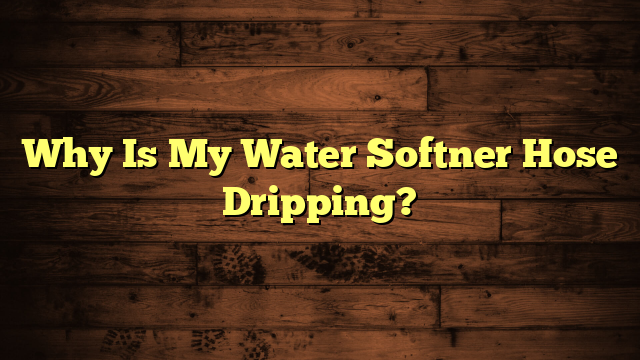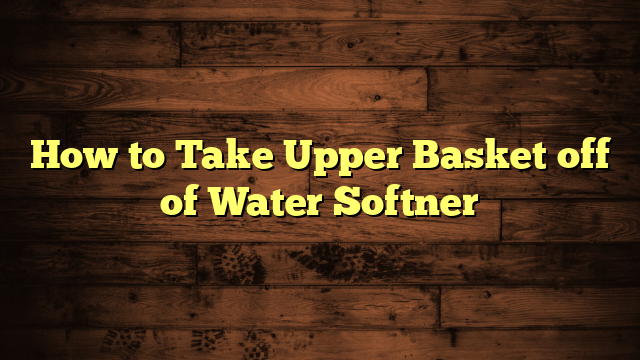Why Is My Water Softner Hose Dripping?
If you've noticed your water softener hose dripping, you're likely wondering what's causing it. This issue can arise from several factors, such as worn hoses, loose connections, or even high water pressure. A quick inspection might reveal some obvious signs, but sometimes the problem isn't so straightforward. Understanding the underlying causes is essential for preventing further issues, and you might be surprised by how simple solutions can make a difference. Before you reach for that wrench, let's explore what you should check first to address this nagging problem effectively.
Key Takeaways
- Worn or damaged hoses may have cracks or holes, leading to drips that need immediate attention.
- Loose fittings at connection points can create leaks; tighten them to resolve the issue.
- High water pressure exceeding the hose's capacity can cause leaking; check with a pressure gauge.
- Kinks or blockages in the hose can build up pressure and result in dripping.
- Regular inspections and maintenance of hoses and connections can prevent leaks and ensure optimal performance.
Common Causes of Dripping
A dripping water softener hose can be frustrating, and understanding its common causes can help you tackle the issue effectively.
One frequent culprit behind these dripping issues is a worn or damaged hose. Over time, wear and tear can lead to cracks or holes, allowing water to seep out. Regular hose maintenance is crucial; inspecting the hose for any signs of deterioration can prevent more significant problems down the line.
Another common cause is loose fittings. If the connections between the hose and the water softener aren't tight enough, it can lead to leaks. You'll want to check and tighten these fittings to ensure a proper seal.
Additionally, high water pressure can contribute to dripping. If your system operates at pressure levels that exceed the hose's capacity, it may cause leaks. Consider using a pressure regulator if you suspect this is an issue.
Lastly, blockages or kinks in the hose can create pressure build-up, leading to dripping. Make it a habit to regularly check for any kinks and keep the hose clear of obstructions.
Inspecting Hose Connections
When you notice a drip, start by checking the hose connections for any loose fittings.
Tightening these connections can often resolve the issue.
Next, examine the integrity of the washers; a worn or damaged washer might be the culprit behind the leak.
Check for Loose Fittings
Inspecting hose connections is crucial in addressing a dripping water softener hose. One of the first things you should do is check for loose fittings. Loose hose fittings can cause leaks, leading to water dripping from your system. Make sure all connections are tight and secure. Here's a quick guide to help you identify and address loose fittings:
| Step | Action |
|---|---|
| 1. Visual Inspection | Look for any visible gaps in hose connections. |
| 2. Hand Tighten | Use your hands to tighten any loose fittings. |
| 3. Use Tools | If necessary, use pliers to secure connections further. |
| 4. Test for Leaks | Turn on the water and observe if any dripping occurs. |
Examine Washer Integrity
After ensuring the hose fittings are tight, the next step involves examining the integrity of the washers.
These small but crucial components play a significant role in preventing leaks. Start by inspecting the washers for any signs of wear and tear. If they're cracked, brittle, or discolored, that's a clear indicator they need replacing.
Consider the washer age as well. If your washers are several years old, it's wise to replace them even if they appear intact. Over time, materials can degrade, leading to potential leaks.
When looking at replacement options, make sure to choose the right size and material compatible with your hose setup.
While you're shopping for new washers, it's a good idea to buy a few extras. This way, you'll have them on hand for future repairs.
Once you've replaced any compromised washers, reattach the hose and check for leaks again. Taking these steps can help ensure your water softener operates efficiently without the annoyance of dripping hoses.
Checking for Cracks or Damage
When checking for cracks or damage in your water softener hose, start by inspecting the hose connections closely.
Examine the material for any signs of wear, and don't forget to look for kinks that might restrict water flow.
Catching these issues early can save you from bigger problems down the line.
Inspect Hose Connections
Regularly checking the hose connections of your water softener is crucial to maintaining its efficiency and preventing leaks. Start by inspecting all visible connections for signs of wear or damage. Different hose types, including rubber and braided options, can have unique vulnerabilities, so be attentive to their specific characteristics.
Look closely for cracks, fraying, or any signs of deterioration. If you notice any issues, it's essential to address them promptly. Damaged hoses can lead to leaks that not only waste water but also compromise your water softener's performance.
Next, evaluate the connection materials. Metal fittings can corrode over time, while plastic connectors may become brittle or cracked. Make sure these connections are tight, as loose fittings can also contribute to dripping. If you find any loose connections, tighten them gently but firmly.
If you can't resolve the issue through simple adjustments, consider replacing the damaged hose or connections. Doing this will ensure your water softener operates smoothly and efficiently, keeping your home's water supply in top condition.
Regular inspection is a small task that can save you from larger problems down the line.
Examine Hose Material
Frequently examining the material of your water softener hose is essential for identifying potential issues like cracks or damage. Different hose types, such as rubber, vinyl, and reinforced polyester, have varying levels of material durability. Understanding these differences can help you spot problems before they escalate.
Start by inspecting the entire length of the hose. Look for any visible cracks, bulges, or signs of wear. Even small imperfections can lead to leaks over time. Pay particular attention to the areas near the connections, as these spots are often under the most stress and can show signs of deterioration first.
If your hose is made from a less durable material, consider replacing it with a higher-quality option that can withstand the pressures of water flow and environmental factors. A durable hose not only minimizes the risk of leaks but also extends the life of your water softening system.
Lastly, make it a habit to check the hose regularly. By staying proactive, you'll ensure that minor issues don't turn into major headaches, keeping your water softener functioning smoothly.
Look for Kinks
After checking the hose material for cracks or damage, it's important to examine the hose for kinks. Kinks can restrict water flow and lead to leaks, causing that annoying dripping issue you're dealing with. You should carefully inspect the entire length of the hose, looking for any twists or bends that could indicate a kink.
Kink prevention starts with proper hose flexibility. If your hose is too rigid or improperly coiled, it's more prone to kinking. Make sure to store the hose in a way that keeps it straight and untangled, avoiding sharp bends.
If you find any kinks, gently work them out by hand, ensuring you don't apply too much pressure, which could cause further damage.
Also, consider replacing old or damaged hoses with more flexible options designed to resist kinks. This proactive approach not only solves your current dripping problem but also helps prevent future issues.
Evaluating Water Pressure Levels
Understanding your home's water pressure levels is crucial for maintaining a properly functioning water softener. If your water pressure is too high, it can lead to leaks, including that annoying drip from your water softener hose. On the other hand, low pressure may prevent the softener from working effectively.
To evaluate your water pressure, you can use a pressure gauge, which is typically available at hardware stores. Once you have your reading, you'll want to ensure that your system includes proper pressure regulation and pressure relief mechanisms. Here's a quick reference table to help you assess your water pressure:
| Pressure Level | Description |
|---|---|
| Below 40 psi | Low pressure; may affect performance |
| 40-60 psi | Ideal range for most systems |
| 60-80 psi | Acceptable but monitor for leaks |
| Above 80 psi | High pressure; regulate immediately |
| Over 100 psi | Very high; risk of damage |
Understanding Installation Issues
Improper installation can often be the root cause of a dripping water softener hose. When you're setting up your system, it's crucial to pay attention to the details.
Installation mistakes can lead to leaks, and understanding these common issues can save you time and money down the line.
Here are some key factors to consider:
- Hose Connections: Ensure all connections are tight and secure to prevent leaks.
- Proper Placement: Make sure the hose isn't kinked or bent, as this can restrict water flow and cause pressure build-up.
- Level Installation: Your unit should be level to avoid water pooling at the connection points.
- Use of Teflon Tape: Applying Teflon tape on threaded connections can help create a watertight seal.
Maintenance Tips for Prevention
Regular maintenance is essential to prevent issues like a dripping water softener hose. By implementing some simple preventive measures, you can save yourself from potential headaches down the line. Start with routine checks every month to ensure everything's functioning properly.
Here's a quick reference table for maintenance tasks:
| Task | Frequency |
|---|---|
| Inspect hoses for wear | Monthly |
| Check valve connections | Monthly |
| Clean the brine tank | Every 6 months |
| Replace filters | Every 6 months |
| Test water hardness | Annually |
Make it a habit to check for leaks at hose connections and ensure there's no buildup around the valves. If you notice any signs of wear, replace the hoses immediately to avoid future drips. Additionally, keep an eye on the salt level in the brine tank; a low salt level can lead to inefficiencies and potential leaks. Remember, a little vigilance now can help you avoid bigger, costlier problems later. Stay proactive, and your water softener will serve you well!
When to Call a Professional
Recognizing when to call a professional can save you time and prevent further damage to your water softener system. While some minor issues can be addressed on your own, certain situations require a professional assessment to ensure your plumbing expertise is up to par.
Consider reaching out to a professional if you notice any of the following:
- Persistent Dripping: If the hose continues to drip despite your efforts to tighten connections or replace seals.
- Water Quality Issues: If you experience unusual water hardness or taste, it could indicate a deeper problem with the system.
- Unusual Noises: Sounds like hissing, bubbling, or banging may suggest internal issues that need expert attention.
- Leaks Beyond the Hose: If water is pooling around the unit, it might be a sign of a serious problem that needs immediate care.
Don't hesitate to seek help from a qualified plumber. They've the necessary tools and knowledge to diagnose and fix the issue effectively, preventing further complications down the line.
Trusting a professional can give you peace of mind and ensure your water softener operates efficiently.
Frequently Asked Questions
Can I Temporarily Seal a Dripping Hose With Tape?
Yes, you can temporarily seal a dripping hose with tape. However, remember that this is just a quick fix. Proper hose maintenance is essential for long-term solutions, so consider repairing or replacing the hose soon.
How Often Should I Inspect My Water Softener Hoses?
You should inspect your water softener hoses at least once a month. Regular hose maintenance helps you catch leaks early, ensuring your system runs efficiently and prolonging its lifespan. Stay proactive to avoid bigger issues later.
What Are the Signs of a Failing Water Softener?
If your water softener's showing signs like insufficient softening, unusual noises, or leaks, it might be failing. Regular water softener maintenance and timely hose replacement can help prevent bigger issues down the line.
Does Hard Water Affect Hose Performance?
Yes, hard water can negatively impact hose performance. It leads to mineral buildup, reducing water flow and potentially causing clogs. Regular maintenance and using a water softener can help keep your hoses functioning effectively.
Is Dripping Water From the Hose Harmful to My Home?
Dripping water from the hose can lead to water damage in your home. It may cause plumbing issues over time, so you should address it quickly to prevent costly repairs and maintain your home's integrity.
Conclusion
In conclusion, if your water softener hose is dripping, it's essential to identify the cause quickly. By inspecting connections, checking for damage, and evaluating water pressure, you can often resolve the issue yourself. Regular maintenance can prevent leaks from becoming bigger problems. However, if you're unsure or the problem persists, don't hesitate to call a professional. Taking action now can save you time, money, and hassle down the line.







